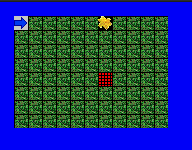 The Jeroo’s World
The Jeroo’s World
The Jeroo Simulator 
![]()
 The Jeroo’s World The Jeroo’s World |
| Santong island is an uninhabited speck of land in the South Pacific Ocean. In the late 1980’s, naturalist Jessica Tong discovered two previously unknown species that are unique to this island. One is the jeroo, a rare mammal similar to the wallabies of Australia. The other is the large winsum flower that is the jeroo’s primary food source. |
| Like its distant Australian relative, the jeroo moves by hopping, but its movements are unique in all of nature. Each jeroo only moves in one of the four main compass directions, and only turns in 90 degree increments. This unusual behavior continues to mystify Jessica and the few other researchers who have observed jeroos in the wild. Some believe that this behavior is somehow related to the geomagnetic lines, but others think that this is just a bizarre learned behavior. |
| Every jeroo has a pouch. While the female uses her pouch to protect and nurture her offspring, both sexes use their pouches to carry winsum flowers that they have picked. Despite living on Santong island for uncounted millennia, the jeroos are extremely poor swimmers. While they are keenly aware of their immediate surroundings, jeroos can be careless. If one happens to hop into the ocean, its fur becomes waterlogged very quickly, and it must rest in the sun for a few hours before resuming its normal activity. In what can only be described as a telepathic connection, all other jeroos also cease their activities until the wet jeroo has recovered. |
| Until recently, the jeroos were safe from human interference because they were only known to a handful of researchers and because Santong island is very small, very remote, and missing from most maps. The jeroos’ idyllic world was interrupted in 2001, when Brian arrived at the Island. Brian is a renowned collector who was hired to capture a jeroo for the extreme animal exhibit at Missouri’s C. A. Baret zoo. Having studied the jeroos’ unique patterns of movement, Brian periodically sets nets in the locations that a jeroo is likely to visit. Fortunately, the sensitive jeroos can detect his nets, and have learned that tossing a winsum flower onto a net will disable the net and make that location safe for future travel. Brian can only catch a careless jeroo that leaps before it looks. |
The Jeroo Simulator |
| After returning from a recent trip to Santong Island, Jessica asked her colleague, Deanna, to develop a simulator that could be used to demonstrate the jeroos and their relationship with their island. The result of Deanna’s work is a computer program, named Jeroo, and a Jeroo programming language that work together to help Jessica with her research. The Jeroo language allows a programmer to direct the movements of up to four jeroos. The simulator contains a visual component that allows one to see the results of running a Jeroo program. When Deanna designed the simulator, she used the jeroos’ unique movements to model the island as a grid of rows and columns similar to a spreadsheet. There are 24 rows and 24 columns. The rows run East and West along lines of latitude, and the columns run North and South along lines of longitude. Each element (cell) of this model corresponds to a location where a jeroo might land when it hops. |
| Deanna chose to number both the rows and columns starting with zero at the northwest corner of the island. When asked why she started at zero, Deanna said that she was counting the number of safe hops from any location to the northwest corner. |
| We will use the notation (r,c) to indicate a specific cell, where r represents the row number of the cell, and c represents its column number. For example, (4,5) indicates the cell in row number 4 and column number 5. |